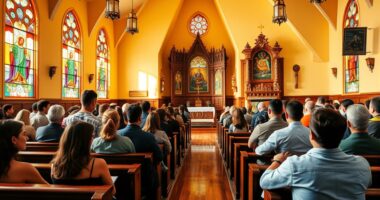Baptism for the dead is a Christian practice where living members are baptized on behalf of those who have passed away, hoping to offer them salvation. Based on biblical references like 1 Corinthians 15:29, it symbolizes hope, spiritual renewal, and the connection between generations. While it plays a significant role in some traditions like The Church of Jesus Christ of Latter-day Saints, many mainstream Christian groups don’t practice it. If you want to understand its origins, meaning, and debates, keep exploring further.
Key Takeaways
- Baptism for the dead is a proxy ritual where living members perform baptisms on behalf of deceased individuals.
- It is based on biblical references, especially 1 Corinthians 15:29, but its practice and meaning are debated among Christians.
- The ritual symbolizes hope for salvation and eternal life for those who have passed without receiving baptism.
- The practice emphasizes intergenerational bonds and the belief in posthumous opportunities for salvation.
- Mainstream Christianity generally rejects baptism for the dead, viewing it as non-standard or doctrinally unendorsed.
The Origins and History of Baptism for the Dead

The practice of baptism for the dead has ancient roots that trace back to early Christian communities and even earlier traditions. You might notice similarities with ancestor worship, where honoring ancestors played a crucial role in spiritual practices. Early Christians incorporated ritual symbolism, viewing baptism as a meaningful act that connects the living with the spiritual domain. This ritual served as a symbol of hope, redemption, and continuity across generations. It reflected a belief that through baptism, the dead could benefit spiritually, bridging the gap between life and the afterlife. These practices were often intertwined with cultural traditions, emphasizing the importance of honoring ancestors and maintaining spiritual bonds beyond death. Over time, this ritual evolved into a distinct religious practice with deep historical and symbolic significance.
Scriptural Foundations and Biblical References
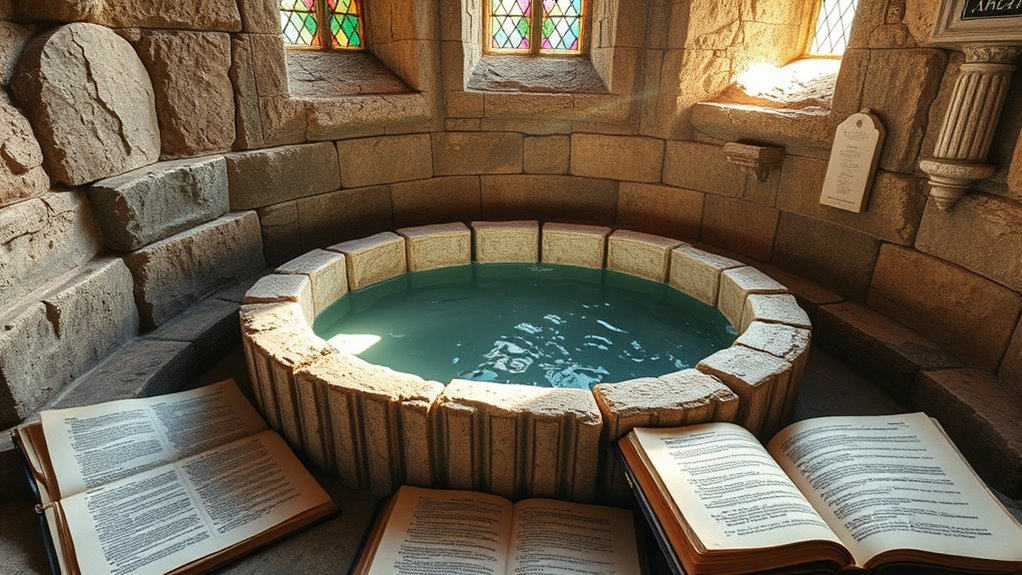
You’ll want to examine where the Bible mentions baptism for the dead and what those passages imply. Key scriptures, like 1 Corinthians 15:29, often come up in this discussion, but their meaning can be misunderstood. Understanding the context and differing interpretations helps clarify how these biblical references support or challenge the practice.
Biblical Mentions Overview
Have biblical texts truly addressed the practice of baptism for the dead? Not directly. Most references are brief and open to interpretation. Some point to 1 Corinthians 15:29, where Paul mentions believers being baptized for the dead, but scholars debate its meaning, considering historical practices and cultural context. These texts don’t explicitly endorse the practice but have fueled modern debates among theologians and denominations. Throughout history, various groups have interpreted these passages differently, leading to diverse views on whether baptism for the dead aligns with biblical teachings. While the Bible mentions baptism and the afterlife separately, it doesn’t clearly outline a practice of baptizing for the dead. Your understanding depends on evaluating these sparse references and their historical and theological implications.
Key Scriptural Passages
Examining the key scriptural passages related to baptism for the dead requires careful attention to specific verses that mention baptism, the afterlife, or related concepts. 1 Corinthians 15:29 is central, where Paul references baptism for the dead, highlighting sacramental symbolism and its faith implications. This passage suggests that early Christians practiced a form of vicarious baptism, symbolizing hope in resurrection and eternal life. Additionally, 1 Peter 3:21 speaks of baptism as an appeal to God for a clear conscience, emphasizing its spiritual significance. These verses collectively underscore that baptism for the dead isn’t merely ritual but carries profound faith implications, symbolizing belief in salvation, divine grace, and the hope of resurrection for all, including those who have passed away.
Context and Interpretation
Understanding the context and interpretation of baptism for the dead requires examining the biblical passages that mention it and taking into account their historical and theological settings. You’ll find that these passages, especially in 1 Corinthians 15:29, have sparked significant historical debates and doctrinal controversies. Scholars differ on whether Paul’s mention of baptism for the dead refers to a practice among early Christians or a rhetorical device. To interpret these references accurately, you need to consider the cultural and religious background of the time, including how early Christians understood salvation and afterlife. Recognizing these complexities helps clarify why baptism for the dead remains a debated topic, with interpretations varying across Christian traditions and theological perspectives.
The Ritual and Process of Baptism for the Dead
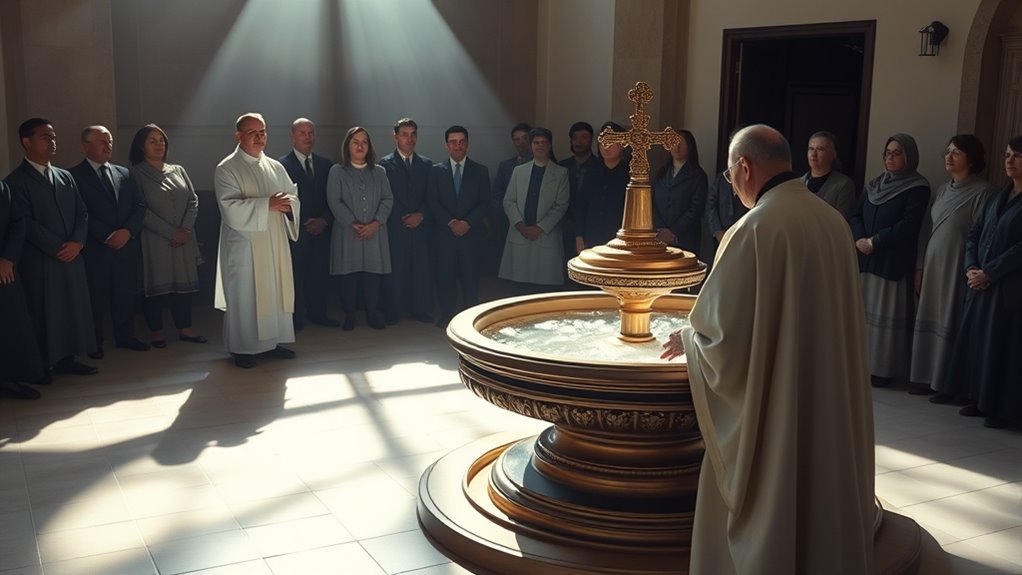
The ritual of baptism for the dead involves performing a baptism on behalf of deceased individuals, allowing the living to act as proxies. This process emphasizes spiritual symbolism, connecting the living with those who have passed. During these baptism rituals, you typically participate in a sacred water immersion that signifies renewal and salvation.
Here are three key steps in the process:
- You prepare by wearing appropriate clothing, often white, symbolizing purity.
- You perform the baptism by immersing yourself in water, reciting specific words linked to baptism rituals.
- The act is witnessed by others, creating a communal bond and spiritual connection.
This ritual is not just symbolic; it embodies the hope of eternal life for those who have passed, rooted in deep spiritual symbolism.
Theological Significance and Purpose
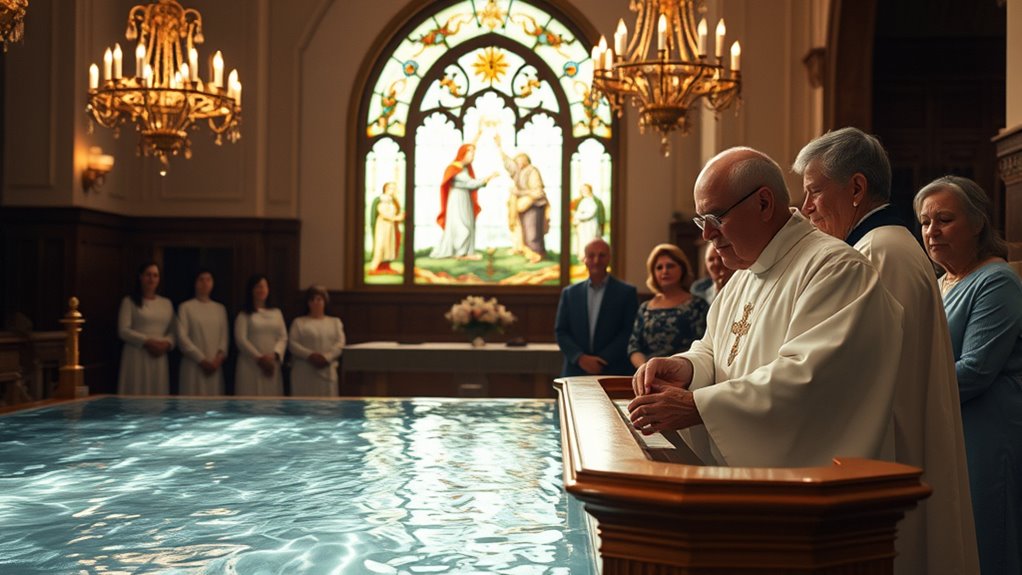
Baptism for the dead holds profound theological significance because it offers living members a way to fulfill divine commandments and extend salvation to those who have passed away without receiving this ordinance in mortality. It embodies salvation symbolism, showing that spiritual progress isn’t limited by mortality. This practice also reflects ancestral veneration, honoring loved ones and connecting generations through sacred rites. By performing baptisms for the deceased, you participate in God’s plan of salvation, emphasizing the importance of agency and eternal progression. Here’s a quick comparison:
| Purpose | Significance |
|---|---|
| Fulfill divine commandments | Extends salvation beyond mortality |
| Salvation symbolism | Demonstrates hope and faith in eternal life |
| Ancestral veneration | Honors and connects with ancestors |
| Spiritual progression | Emphasizes ongoing spiritual growth |
Common Misunderstandings and Clarifications

Many misconceptions surround baptism for the dead, leading some to misunderstand its purpose and significance. Some think it’s about ancestor veneration or symbolic baptism for the living, but that’s not accurate. Here are clarifications:
Many misconceptions exist about baptism for the dead, often confusing its purpose and significance.
- It’s not a form of ancestor worship but a symbolic baptism on behalf of those who didn’t have the chance.
- It doesn’t imply that the dead are automatically saved; rather, it offers them the opportunity to accept or reject it.
- It’s not a shortcut for salvation but a means to extend the blessings of the gospel to those who’ve passed away.
Understanding these points helps clarify that baptism for the dead is about offering opportunities, not replacing personal faith or veneration practices.
Practices and Beliefs in The Church of Jesus Christ of Latter-day Saints
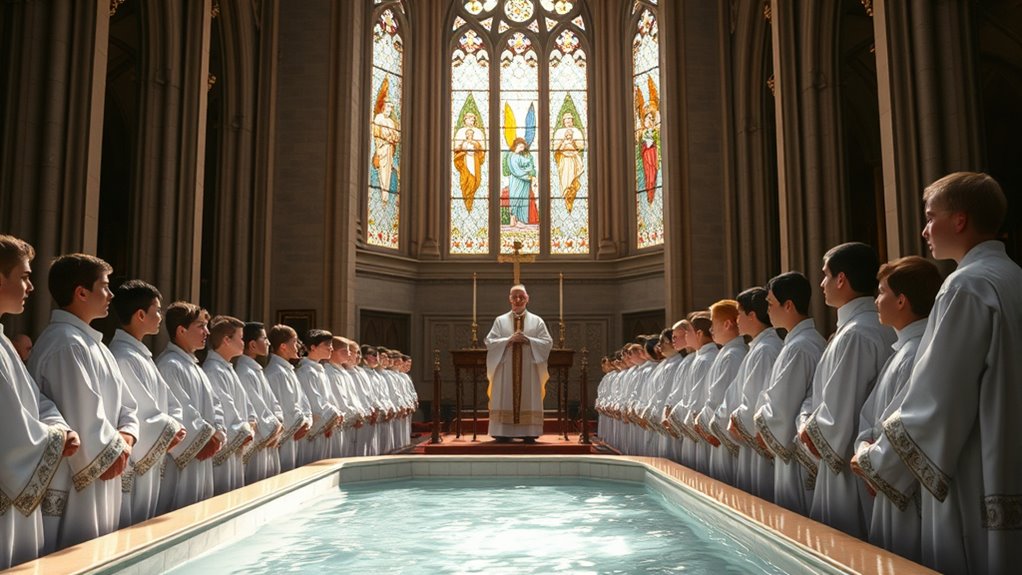
Practices and beliefs in The Church of Jesus Christ of Latter-day Saints emphasize the importance of ordinances like baptism, which are seen as essential steps in following Jesus Christ. You believe that baptism for the dead allows living members to perform sacred rites on behalf of deceased ancestors, offering them the chance to accept the gospel. The church also values ancestor veneration, honoring your family’s lineage and connecting you to your heritage through these rituals. Ritual symbolism plays a significant role, with water baptism representing purification and rebirth. These practices underscore your commitment to family and faith, reinforcing the idea that sacred ordinances extend beyond this life. By participating, you strengthen your spiritual bonds and help fulfill divine commandments regarding family and eternal salvation.
How Baptism for the Dead Fits Into Broader Christian Theology
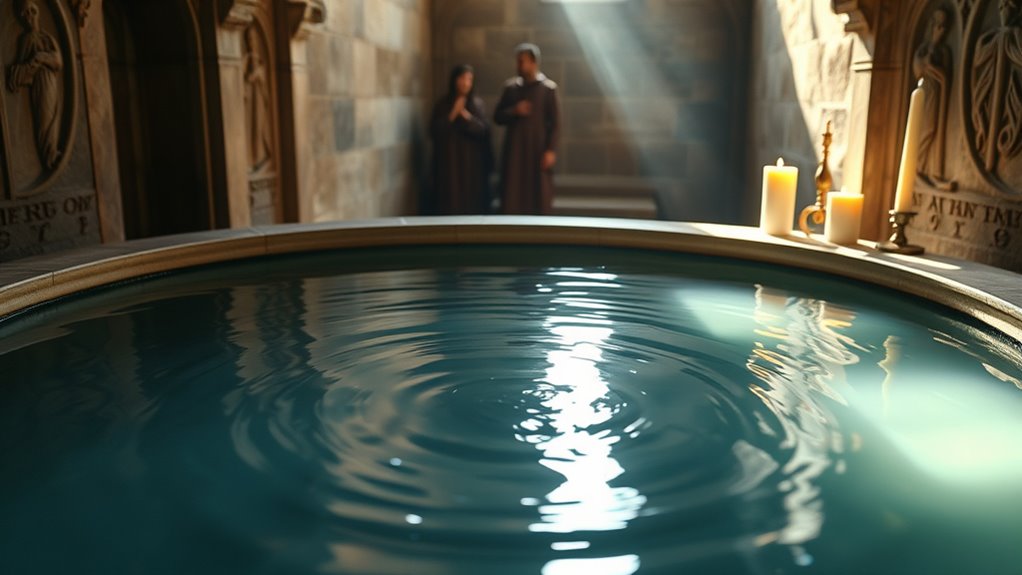
The concept of baptism for the dead raises significant questions when viewed through the lens of broader Christian theology, which traditionally emphasizes individual accountability and personal faith. You might wonder how this practice aligns with core doctrines. To understand its place in salvation history and doctrinal development, consider these points:
- It reflects the belief that salvation isn’t limited to the living but extends across generations.
- It shows an evolving understanding of grace and the afterlife within certain Christian traditions.
- It highlights differences in doctrinal development, where some groups see it as a way to include those who couldn’t choose faith in life.
While mainstream Christianity often rejects this practice, its roots in salvation history reveal a broader view of God’s mercy and the ongoing nature of doctrinal growth.
Frequently Asked Questions
Can Non-Latter-Day Saints Participate in Baptism for the Dead?
You might wonder if non-Latter-day Saints can participate in baptism for the dead. Generally, the practice is reserved for members of The Church of Jesus Christ of Latter-day Saints. Interfaith participation is typically discouraged due to theological debates about the sacred nature of the ordinance. If you’re not a member, it’s best to respect these beliefs and understand that this practice is exclusive to church members.
Is Baptism for the Dead Practiced in Other Christian Denominations?
When you ask if baptism for the dead is practiced in other Christian denominations, you see that interfaith perspectives vary widely. Historically, its origins are mainly linked to the Church of Jesus Christ of Latter-day Saints. Most mainstream Christian groups, however, don’t practice it, viewing baptism as a personal decision. You might find some small, historical groups experimenting with similar concepts, but it remains largely unique to Mormon traditions.
How Are Deceased Individuals Chosen for Baptism in This Practice?
You might think selecting who gets baptized for the dead is like finding a needle in a haystack, but it’s based on ancestral connection and spiritual eligibility. Practitioners believe they choose individuals who had no opportunity in life to accept the faith. They perform baptism on behalf of the deceased, trusting that those with a true spiritual connection are open to the blessings and salvation offered through this sacred act.
What Are the Ethical Considerations Surrounding Baptism for the Dead?
You should consider the ethical issues surrounding baptism for the dead, especially consent considerations. Many question whether it’s appropriate to perform this practice without the deceased’s explicit consent, raising moral concerns. Additionally, doctrinal disagreements exist, with some faiths viewing it as essential, while others oppose it due to ethical doubts. Respecting individual beliefs and ensuring transparent practices are vital to addressing these ethical challenges responsibly.
How Does Baptism for the Dead Relate to Salvation and Eternal Life?
Imagine baptism as a bridge to eternal life, a symbol of hope and renewal. When you learn about baptism for the dead, you see it as offering salvation implications for those who couldn’t receive it in life. This practice signifies a connection beyond death, emphasizing the eternal life significance for all. It reflects a compassionate belief that everyone can find a pathway to salvation, even after this life ends.
Conclusion
So, next time you hear about baptism for the dead, remember—it’s not just a quirky Mormon practice. It’s a profound act of hope and connection across time, all rooted in faith and scripture. Ironically, while many overlook its significance, it offers a unique glimpse into the desire to unite families and souls beyond mortality. Maybe, just maybe, there’s more to this ritual than meets the eye—and it’s worth understanding.





